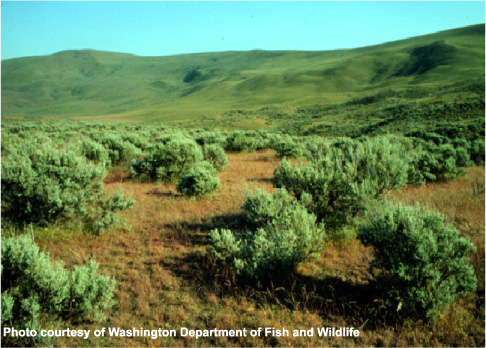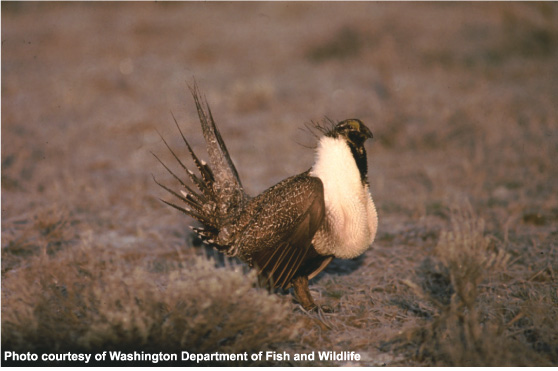Along with riparian
corridors, shrub and grassland habitats contain the greatest biodiversity
of wildlife in the Greater Yellowstone Ecosystem (GYE) (Greater Yellowstone
Coalition 2002). Many species are critically dependent on sagebrush, or
shrubsteppe habitat, including sage grouse, Townsend’s ground squirrel,
loggerhead shrike, ferruginous hawk and northern harrier. The fragmentation
and loss of this habitat type is a unique threat to the biodiversity of
the GYE.

Until 100 years
ago, shrub-steppe habitat covered 200,000 square miles (128,000,000 acres)
in the western United States (Pacific Northwest Laboratories 2002).
Current coverage by shrub-steppe vegetation
is much smaller. Public lands are often managed for wildlife values, and
large tracts of government-managed shrubsteppe habitat are left intact.
However, private shrubsteppe lands in the west, in small checkerboard plots
left as a legacy from the government railroad land grants in the 19th century,
are more likely to be converted and used for other purposes, such as agriculture,
grazing or development. About 3,240,000 acres of grasslands in the GYE
are privately owned, 64% of which is used as range or pasture (Greater Yellowstone
Coalition 2002).
This land conversion results in a loss of habitat quality for sage-dependent wildlife. While it is thought that rangelands can provide some habitat values for sage-dependent wildlife, repeated disturbance that accompanies typical rangeland management, such as over-grazing, soil erosion and increased fire frequency, can lead to cheat grass invasion and reduction in sage cover.
In addition, due to skyrocketing land prices, large pieces of privately-owned rangeland, which might provide habitat for these shrubsteppe species, are being subdivided and sold to developers. Because developers pay more for these tracts of land than ranchers can make grazing them, as of 1991, more than 1 million acres of farmland in the GYE had been subdivided (Witkowsky and Lawlor, 1995). This results in an overall reduction in the amount of shrubsteppe habitat in this area.
The loss of much of the shrub-steppe habitat across the west has been blamed for the decline of many species. The loggerhead shrike has been declining since 1996, and this decline is usually blamed on loss of habitat (Cade and Woods 1997). Perhaps most strikingly in May of 1999, a petition was filed to list the western or northern sage grouse in Washington State as a threatened species under the Endangered Species Act.

The sage grouse has declined by an average of 33% between 1985 and 1995 across its range (Aldridge and Brigham 2001). Sage grouse are heavily dependent on sagebrush, and the loss of shrubsteppe habitat due to human activities has been identified as a cause of population declines (Braun 1995, Schroeder 1999), largely due to reduced nesting success. Sage grouse require large expanses of shrubsteppe habitat and heterogeneous sage structure for various uses, including nesting, breeding and winter forage (Connelly et al. 2000). Land conversion and subdivision contribute to a reduction in these habitat characteristics.
Conservation efforts for shrubsteppe-dependent wildlife such as sage grouse will require that management strategies are applied across boundaries of land ownership. Because of the checkerboard land ownership pattern left as a legacy of government land grants to the railroads, public and private landowners will have to work in concert to ensure sufficient habitat for shrubsteppe species year-round. Management recommendations for the protection of sage grouse and shrubsteppe habitat include protecting sage habitat within 18 kilometers of migratory sage grouse leks (Connelly et al. 2000). This type of prescription is only possible with joint efforts by private and public landowners.

References:
Aldridge, CL and Brigham, RM. 2001. Nesting and reproductive activities of Greater Sage-Grouse in a declining northern fringe population. Condor 103 (3): 537-543.
Cade, TJ and Woods, CP. 1997. Changes in distribution and abundance of the Loggerhead Shrike. Conservation Biology 11 (1): 21-31.
Connelly, JW; Schroeder, MA; Sands, AR; and Braun, CE. 2000. Guidelines to manage sage grouse populations and their habitats. Wildlife Society Bulletin 28 (4): 967-985.
Greater Yellowstone Coalition. 2002. http://www.greateryellowstone.org
Pacific Northwest National Laboratory. 2002. Shrub-Steppe Series: What about Shrub-Steppe? http://www.pnl.gov/pals/resource_cards/ShrubSteppe.html
Washington Department of Fish and Wildlife Shrubsteppe research page
http://www.wa.gov/wdfw/wlm/research/songbird/shrub.htm#SHRUBSTEPPE
Witkowsky, Kathy and James Lawlor. 1995. Montana under the gun. Planning 61: 4-10.
This land conversion results in a loss of habitat quality for sage-dependent wildlife. While it is thought that rangelands can provide some habitat values for sage-dependent wildlife, repeated disturbance that accompanies typical rangeland management, such as over-grazing, soil erosion and increased fire frequency, can lead to cheat grass invasion and reduction in sage cover.
In addition, due to skyrocketing land prices, large pieces of privately-owned rangeland, which might provide habitat for these shrubsteppe species, are being subdivided and sold to developers. Because developers pay more for these tracts of land than ranchers can make grazing them, as of 1991, more than 1 million acres of farmland in the GYE had been subdivided (Witkowsky and Lawlor, 1995). This results in an overall reduction in the amount of shrubsteppe habitat in this area.
The loss of much of the shrub-steppe habitat across the west has been blamed for the decline of many species. The loggerhead shrike has been declining since 1996, and this decline is usually blamed on loss of habitat (Cade and Woods 1997). Perhaps most strikingly in May of 1999, a petition was filed to list the western or northern sage grouse in Washington State as a threatened species under the Endangered Species Act.

The sage grouse has declined by an average of 33% between 1985 and 1995 across its range (Aldridge and Brigham 2001). Sage grouse are heavily dependent on sagebrush, and the loss of shrubsteppe habitat due to human activities has been identified as a cause of population declines (Braun 1995, Schroeder 1999), largely due to reduced nesting success. Sage grouse require large expanses of shrubsteppe habitat and heterogeneous sage structure for various uses, including nesting, breeding and winter forage (Connelly et al. 2000). Land conversion and subdivision contribute to a reduction in these habitat characteristics.
Conservation efforts for shrubsteppe-dependent wildlife such as sage grouse will require that management strategies are applied across boundaries of land ownership. Because of the checkerboard land ownership pattern left as a legacy of government land grants to the railroads, public and private landowners will have to work in concert to ensure sufficient habitat for shrubsteppe species year-round. Management recommendations for the protection of sage grouse and shrubsteppe habitat include protecting sage habitat within 18 kilometers of migratory sage grouse leks (Connelly et al. 2000). This type of prescription is only possible with joint efforts by private and public landowners.

References:
Aldridge, CL and Brigham, RM. 2001. Nesting and reproductive activities of Greater Sage-Grouse in a declining northern fringe population. Condor 103 (3): 537-543.
Cade, TJ and Woods, CP. 1997. Changes in distribution and abundance of the Loggerhead Shrike. Conservation Biology 11 (1): 21-31.
Connelly, JW; Schroeder, MA; Sands, AR; and Braun, CE. 2000. Guidelines to manage sage grouse populations and their habitats. Wildlife Society Bulletin 28 (4): 967-985.
Greater Yellowstone Coalition. 2002. http://www.greateryellowstone.org
Pacific Northwest National Laboratory. 2002. Shrub-Steppe Series: What about Shrub-Steppe? http://www.pnl.gov/pals/resource_cards/ShrubSteppe.html
Washington Department of Fish and Wildlife Shrubsteppe research page
http://www.wa.gov/wdfw/wlm/research/songbird/shrub.htm#SHRUBSTEPPE
Witkowsky, Kathy and James Lawlor. 1995. Montana under the gun. Planning 61: 4-10.